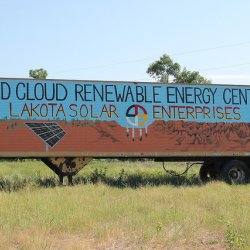The dawn is very beautiful with pink, dark blue, and yellow all spreading like watercolors. It is the beginning of a new day, a new life, a chance to start over again. Dawn is also something indescribable, a promise that there will be continuous life, as long as that star rises in the sky
- Carmen Fourd, from “Walking on Earth and Touching the Sky: Poetry and Prose by Lakota Youth at Red Cloud Indian School”
The vast plains roll to the horizon. Wild grass gives way to ancient rock eroded by wind and rain. The layers of silt and volcanic ash hold stories of time. The history, land, people, and culture of the northern Great Plains impel powerful emotion and reflection. This is a place of great beauty, but also of great challenges.
Here in Shannon County, South Dakota, poverty is endemic, perpetuated by substandard housing and lack of economic infrastructure. In the Pine Ridge reservation and surrounding communities, a growing population of Native youth struggles with uncertain opportunity. Tribal and community leaders are facing these obstacles down by embarking on a path of sustainable community development that embraces cultural values and self-determination.
 In July of 2014, GRID Alternatives staff from California and Colorado traveled to Pine Ridge to support community efforts to install solar technology, build local workforce capacity and create awareness and momentum for a clean energy economy. The project, a partnership with Lakota Solar Enterprises, Oglala Lakota Housing, and Trees Water People, is the first outside of GRID’s primary service area, and marks the beginning of our national tribal program.
In July of 2014, GRID Alternatives staff from California and Colorado traveled to Pine Ridge to support community efforts to install solar technology, build local workforce capacity and create awareness and momentum for a clean energy economy. The project, a partnership with Lakota Solar Enterprises, Oglala Lakota Housing, and Trees Water People, is the first outside of GRID’s primary service area, and marks the beginning of our national tribal program.
Over the course of a week, GRID and our partners conducted a training in PV technology at the Red Cloud Renewable Energy Center, which serves as a training center for Native American students across the country, and completed two demonstration installs with tribal members from the Pine Ridge Reservation.
The first, a 1.9kW ground mount system, will power a newly constructed compressed earth block office which will be used as a learning tool at the energy center.
The second, a 2.3 KW AC roof mount system with Enphase micro-inverters, was installed on a newly constructed Structurally Insulated Panel (SIP) home owned by the Oglala Sioux tribe. The home was built as part of an energy efficient housing demonstration project lead by the Native American Sustainable Housing Initiative; a collaboration of community organizations, Oglala Lakota College and the University of Colorado Boulder.
 Cheyenne Poor Bear, a Lakota tribal member who grew up in Denver, was one of the volunteers. She returns to Pine Ridge regularly with her father to visit family and friends. Her enthusiasm for solar and for sharing what she has learned with other native youth is inspiring.
Cheyenne Poor Bear, a Lakota tribal member who grew up in Denver, was one of the volunteers. She returns to Pine Ridge regularly with her father to visit family and friends. Her enthusiasm for solar and for sharing what she has learned with other native youth is inspiring.
“To me solar means that our elders and children will have access to heat and electricity year round,” said Cheyenne. “The conditions on reservations are so poverty stricken that this isn't always available. Also using a resource (the sun) that we respect and cherish to accomplish this makes it that much better."
Cheyenne’s enthusiasm and passion during the project week won her a scholarship for an six-week on-line women’s PV training class, “Solar Sisters Unite,” offered by Solar Energy International (SEI). Like many of the other trainees and volunteers from this incredible week, Cheyenne hopes to continue working with GRID and being a part of future installations on the Lakota Nation.

